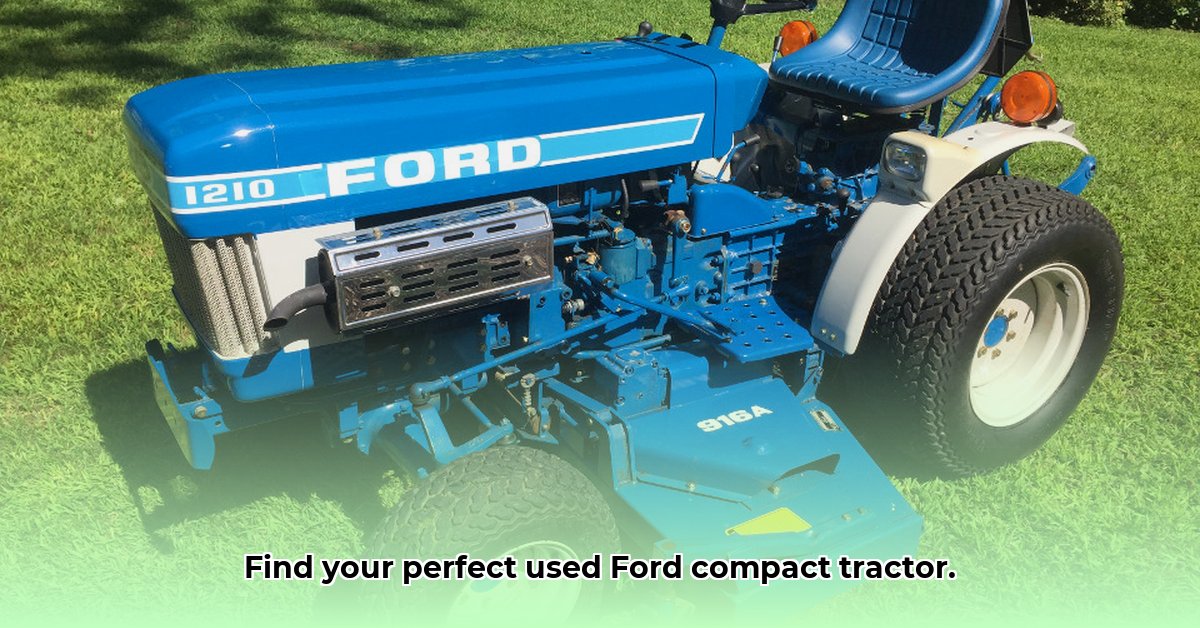
Ford Compact Tractor Models: Your Guide to Finding the Perfect Fit
Thinking about adding a used compact tractor to your arsenal? Ford's reputation for reliability makes their smaller models (under 40 horsepower) a popular choice. This buyer's guide will equip you to make an informed decision, from understanding the various models to negotiating a fair price and planning for long-term ownership. We'll cover everything from where to find the right tractor to securing parts and keeping it running smoothly for years to come. For troubleshooting older models, check out this helpful resource: Ford Tractor Problems.
Popular Ford Compact Tractor Models (Under 40 HP)
Ford's history boasts several iconic compact tractor models. While many older models, like the 8N and 2N, are no longer in production, their robust designs ensure many are still in operation. These older models often offer simpler mechanics, translating to easier maintenance. However, every model presents its unique strengths and weaknesses. Thorough research is vital; investigate specific models based on your needs and budget. Online image searches will greatly assist in visualizing the models and understanding their design elements. Remember to consider factors such as PTO (Power Take-Off – for powering attachments), lift capacity, and overall condition when comparing models.
Buying a Used Ford Tractor: A Step-by-Step Guide
Purchasing a used tractor requires careful planning. This step-by-step guide will lead you through the process, ensuring you make a sound investment.
Assessing Your Needs: Before searching, define your requirements. What tasks will the tractor perform? What size of land will you be working? Knowing this will determine the appropriate horsepower (HP), PTO capabilities, and lift capacity. A clear understanding of your needs will refine your search and prevent purchasing an unsuitable model. Is fuel efficiency a primary concern?
Locating Your Tractor: Several avenues exist for finding used Ford tractors:
- Online Marketplaces: Sites like eBay, Craigslist, and specialized agricultural marketplaces offer a wide selection, but buyer beware! Thorough due diligence is crucial.
- Auctions: Auctions can yield great deals, but competition is fierce. Pre-auction research is vital to avoid overpaying.
- Private Sellers: While offering a more personalized experience, private sales require extra caution and careful inspection.
The Crucial Pre-Purchase Inspection: Never skip this step. Employ a qualified mechanic experienced with older Ford tractors. A comprehensive inspection should include:
- Engine diagnostics: Including compression testing and checks for oil and coolant leaks.
- Hydraulic system evaluation: Checking for leaks and smooth operation of the lift and other functions.
- Transmission assessment: Evaluating smooth shifting and signs of wear.
- Three-point hitch functionality test: Ensuring proper attachment and operation of implements.
- PTO (Power Take-Off) inspection: Verifying reliable power delivery to attachments.
- Overall condition review: Looking for rust, damage, and signs of neglect.
Negotiation and Purchase: Armed with the inspection report, you can confidently negotiate a fair price. Remember to factor in potential repair costs into your budget. Meticulously review all sales paperwork before signing. Is the seller providing any warranty or guarantee? Clarify this upfront.
Securing Parts: A Long-Term Strategy: Finding parts for older Ford tractors may require effort. Explore these options:
- Online Retailers: Many online stores specialize in parts for classic tractors.
- Local Tractor Repair Shops: Local mechanics are often excellent resources for parts and expertise.
- Salvage Yards: Salvage yards might offer cost-effective parts, but careful quality assessment is needed.
Cost Considerations: Ownership and Maintenance
Budgeting for both routine maintenance and potential repairs is crucial. Unexpected issues are inherent with older equipment. Here's a sample cost breakdown:
| Potential Repair | Likelihood | Estimated Cost Range |
|---|---|---|
| Engine Overhaul | Moderate | $1,000 - $3,000 |
| Hydraulic System Repair | Moderate | $500 - $1,500 |
| Transmission Repair | Moderate | $1,000 - $3,000 |
| Electrical System Issues | Low | $200 - $800 |
These are estimates; actual costs depend on location, the severity of the issue, and labor rates. Regular maintenance can significantly reduce future repair costs.
Long-Term Ownership: Strategies for Success
Proactive maintenance is vital to prolong your tractor's lifespan and minimize downtime. Establishing a relationship with a knowledgeable mechanic is invaluable. Maintain detailed maintenance records to aid in future planning. A reliable parts sourcing strategy, as discussed earlier, will ensure ready access to needed components.
Pros and Cons of Owning a Used Ford Compact Tractor
Weighing the pros and cons will solidify your decision-making process.
Pros:
- Lower Purchase Price: Used tractors offer significant cost savings compared to new models.
- Simple Design: Older Ford tractors generally feature simpler mechanics, often facilitating easier maintenance and repairs. (However, this requires some mechanical aptitude or access to someone who possesses it.)
- Durability: Ford tractors are known for their robust construction and ability to withstand considerable use.
Cons:
- Parts Availability: Securing parts for older models can be more challenging than for newer tractors.
- Mechanic Availability: Finding a mechanic familiar with older Ford tractors might require some searching.
- Maintenance Costs: Although the initial purchase is lower, unpredictable maintenance and repair costs are a factor.
Buying a used Ford compact tractor can be extremely rewarding. However, careful attention to detail, thorough pre-purchase inspection, and realistic budgeting are essential for success. With the right approach, you can find a reliable and cost-effective machine that meets your needs for years to come.